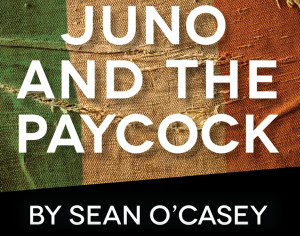The working class tenements of Dublin, Ireland during the Irish Civil War period are not uplifting or contemplative places to set a theatrical production. Sean O’Casey set his Dublin trilogy of working class plays there, and The REP took a large gamble by including in their current season the piece most often done, JUNO AND THE PAYCOCK. Director, Ben Barnes, an Ireland native himself, had a formidable task to address O’Casey’s themes of poverty, war, religion, and nationalism.
Any audience familiar with the dysfunctions many times adapted for the theatre can appreciate the performances of a self-important “master of the house”, a downtrodden wife, a naïve and passive daughter, a wounded (mentally and physically) son, and a ne’er-do-well family friend. But O’Casey takes these struggling souls and further oppresses them with the vagaries of war, the duplicity of the upper class and the self-imposed tyranny of their religion. By saying these things it can be interpreted that there is nothing and no one likeable or understandable but that would be inaccurate. O’Casey’s writing captures the bluster and blarney associated with Irish men but he then twists it into a shape that cannot survive. The haunting refrains of the women saying funereal prayers to the Virgin Mary are both critical and pleading.
Barnes has made bold decisions with which he embraces all of the realities of the Boyle family taking hold of them and forcing the audience to engage with these people. Barnes has decided to raise a ragged curtain on a room which can only be called large by any tenement standards. However, as large as it is, it is also shabby and ill furnished and slowly fills with characters for whom struggle is the majority of their life. The REP ensemble fills many roles with equal levels of aptness and characterization. Whether playing Irregular Irish soldiers or women from the neighborhood, the players are thoughtful and physically appropriate. At no time will the audience realize they have seen any of them before. This is in no small way due to the Costume Designs of Andrea Barrier and the work of the Dialect Coach, Stephen Gabis.
Kathleen Pirkl Tague as Juno Boyle is a masterpiece of what O’Casey himself describes as “…that look of the working class, a look of listless monotony and harassed anxiety…”. Juno is who holds this fractured family together; Juno is who loves and hates and questions and decides how the Boyle family will continue. Erin Partin as Mary Boyle makes her portrayal easy to watch even while her life takes uncomfortable and finally desperate turns. Michael Gotch, as Johnny Boyle, haunts the audience with a resigned, wounded look and unsteady pacing. Act II, however, finds Gotch hallucinating and finally accepting his fate. His character, more than any other, exemplifies the horrors of war and terrifying incongruities when one learns that his injuries were incurred by British soldiers and also by the fragments of Irish society itself.
The “paycock” aka peacock of the piece is Captain Jack Boyle played with gusto and physical bravado by Stephen Pelinski. As long as the Captain has coins in his pocket and friends at “the snug”, the Captain sees no reason to view life as sad. Pelinski allows the audience to “care” about Captain Jack as he tells wild stories about earlier life episodes at sea where he had heroic stature. As the play unfolds, one realizes that Pelinski’s Captain Jack’s stories are just that. By the last scene of the play, it is difficult to care about this man who has so consistently ignored family and the outside world. Lee E. Ernst combines vocal aptitude with a physical presence that makes the appearance of “Joxer” Daly, the Captain’s drinking buddy, someone to be both anticipated and feared. Mic Matarrese plays several roles in this production, but Charles Bentham is the memorable one. He is a one man emotional swing bringing the Boyle family their happiest moments (in which he easily partakes) and also their saddest and most hurtful (in which he is no where to be found).
Not an easy production to undertake or to understand. The REP has done an excellent job in combining multiple elements of realism into a dark and foreboding production of the Sean O’Casey classic, JUNO AND THE PAYCOCK.
Don’t miss this visit to the visceral side of Ireland … you won’t forget it!!
JUNO AND THE PAYCOCK
Written by Sean O’Casey
Directed by Ben Barnes
March 5 – 22, 2015
Resident Ensemble Players
at Roselle Center for the Arts
Newark, DE
302-831-2204
www.rep.udel.edu


